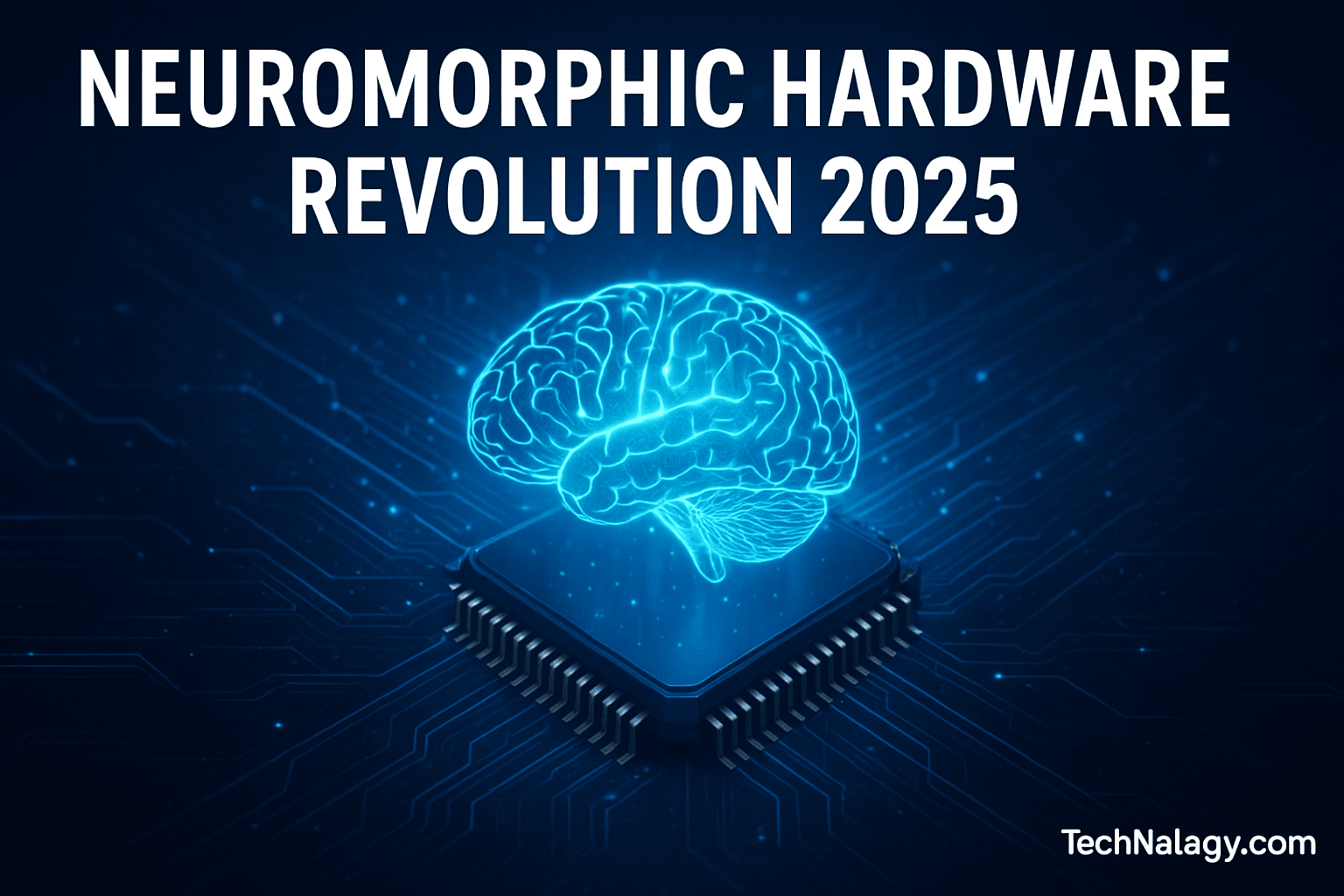🧠 Neuromorphic Hardware 2025: The Rise of Brain-Inspired Computing
Introduction – The Dawn of Brain-Inspired Computing
The world of computing is undergoing a silent revolution. As artificial intelligence grows more complex, the need for faster, smarter, and more energy-efficient hardware has never been greater. Traditional CPUs and GPUs — the backbone of modern technology — are now reaching their physical and performance limits. Enter neuromorphic hardware, the next great leap in computing innovation.
In 2025, this emerging technology is transforming the way machines learn and process information by mimicking the human brain. It’s not just an upgrade; it’s an evolution — a shift from raw computation to adaptive, intelligent, brain-inspired systems that can learn, reason, and evolve.
Table of Contents
What Is Neuromorphic Hardware?
At its core, neuromorphic hardware is designed to emulate the structure and function of the human brain. The concept originated in the 1980s when Carver Mead, a pioneer in electronic engineering, envisioned circuits that could replicate the activity of neurons and synapses.
Unlike the traditional von Neumann architecture, where memory and processing are separated, neuromorphic chips combine both functions — much like how neurons in our brain simultaneously store and process information. This architecture enables incredibly fast communication and low energy consumption.
Neuromorphic computing relies on spiking neural networks (SNNs) — systems that transmit information only when changes occur, just like biological neurons that fire when stimulated. The result is a highly efficient, event-driven approach to processing data.
How Neuromorphic Hardware Works
Spiking Neural Networks (SNNs)
In a spiking neural network, neurons send out electrical pulses or “spikes” only when triggered by events. This allows systems to process sensory input, such as visual or auditory data, in real time. The fewer unnecessary calculations made, the less energy is used — making SNNs a cornerstone of neuromorphic design.
Core Components of Neuromorphic Systems
Neuromorphic architectures combine three main components:
- Artificial Neurons: These act as the core processing units.
- Synapses: They connect neurons and adjust their strength based on experience — a process similar to learning.
- Memristors: These tiny electrical components store data by changing their resistance, mimicking biological memory.
Leading Innovations
Two of the most advanced systems in this field are Intel’s Loihi 2 and IBM’s TrueNorth. Loihi 2 allows for real-time adaptation and self-learning, while IBM’s TrueNorth contains over one million neurons, consuming less power than a household light bulb.
IBM continues to lead global research on this frontier, exploring how brain-inspired architectures are transforming energy efficiency and AI scalability through IBM’s Neuromorphic Computing Overview.
Key Features and Benefits of Neuromorphic Hardware
Neuromorphic chips offer several advantages that set them apart from traditional processors:
- Ultra-Low Power Consumption: Their event-driven design means they process only what’s needed, dramatically reducing energy usage.
- Parallel Computation: Thousands of neurons operate simultaneously, mirroring the brain’s multitasking capabilities.
- Real-Time Learning: These chips can adapt instantly, improving accuracy and decision-making as they process new data.
- Scalability: Suitable for everything from small IoT sensors to large AI data centers.
- Durability and Longevity: With less heat and mechanical wear, neuromorphic chips tend to last longer and perform more consistently.
Real-World Use Cases in 2025 and Beyond
Edge AI and IoT Devices
As smart devices become more prevalent, neuromorphic hardware is enabling local processing at the edge — eliminating the need to constantly send data to the cloud. From drones to smart cameras, neuromorphic processors handle visual and audio data efficiently in real time.
Robotics and Automation
Robots powered by neuromorphic systems can sense and react to their surroundings just like living organisms. This allows autonomous drones, vehicles, and industrial machines to make smarter, safer decisions.
Healthcare and Prosthetics
Neuromorphic processors are revolutionizing healthcare by powering prosthetic limbs that can learn how a patient moves. These systems also enhance diagnostic tools that interpret complex brain and biosensor data in real time.
Smart Cities and Environmental Monitoring
In smart cities, neuromorphic chips help reduce power waste and improve decision-making. They’re used in energy grids, traffic management, and pollution monitoring — creating sustainable, self-learning urban systems.
Challenges and Limitations
Despite its promise, neuromorphic technology faces several challenges:
- High Production Costs: Advanced fabrication techniques are expensive.
- Software Compatibility: Popular AI frameworks are not fully optimized for spiking neural networks.
- Complex Training Models: Teaching SNNs to perform like traditional neural networks is difficult.
- Integration Barriers: Neuromorphic chips are not yet easily compatible with conventional digital hardware.
However, research and open-source initiatives are rapidly addressing these barriers, making neuromorphic systems more accessible and commercially viable.
Major Companies and Research Innovations
Intel – Loihi 2
Intel’s Loihi 2 chip improves on the original by offering more flexible neuron models and greater scalability, making it ideal for AI-driven robotics and Edge AI devices.
IBM – TrueNorth
IBM’s TrueNorth remains one of the most advanced neuromorphic chips, featuring over one million programmable neurons. It’s used in simulations for pattern recognition, image analysis, and sensory data processing.
BrainChip and SynSense
Startups such as BrainChip (with its Akida chip) and SynSense are pushing neuromorphic solutions into consumer markets, powering smart sensors, wearables, and robotics systems.
Academic and Global Research
Institutions like MIT, Stanford, and ETH Zurich are developing new memristor-based designs and algorithms to make neuromorphic systems faster, more stable, and affordable.
Neuromorphic Hardware vs Brain Chips
While both technologies draw inspiration from the human brain, their goals differ. Neuromorphic hardware replicates the brain’s functionality to improve machine intelligence, while brain chip technology focuses on enhancing or repairing human cognitive functions directly inside the body.
In short: brain chips are biological in purpose; neuromorphic systems are computational in design. Yet both are converging toward a future where the boundary between biology and technology grows thinner every day.
Integration with AI and Machine Learning Frameworks
As neuromorphic hardware continues to evolve, researchers are finding ways to merge it with modern AI systems. Many are working to adapt machine learning libraries like TensorFlow and PyTorch for spiking neural networks. This integration allows developers to train models more efficiently and create hybrid architectures that combine GPU acceleration with neuromorphic intelligence.
Such hybrid systems promise adaptive learning, self-correction, and real-time decision-making — the hallmarks of next-generation artificial intelligence.
Neuromorphic Interfaces and Human-Machine Communication
One of the most exciting directions in this field is the rise of neuromorphic interfaces — systems that allow devices to interpret human gestures, speech, and emotions. By combining neuromorphic chips with neural interfaces, researchers are developing communication bridges between humans and machines that feel almost instinctive.
These advances could redefine prosthetics, gaming, accessibility tech, and even human–AI collaboration in workplaces and creative industries.
The Future Outlook – Toward 2030 and Beyond
By 2030, experts predict that neuromorphic hardware will merge with quantum computing and photonic systems, creating AI models that are not only energy-efficient but capable of reasoning at human-like levels.
Autonomous vehicles, robotics, and even space technology are expected to benefit from this evolution. Imagine spacecraft that can make split-second navigational decisions, or home robots that understand emotions and adapt to your needs.
The combination of neuroscience, AI, and advanced chip engineering marks a new phase in humanity’s digital evolution — one where machines will think, adapt, and evolve alongside us.
Conclusion – The Thinking Machines of Tomorrow
As we step deeper into 2025, neuromorphic hardware stands as one of the most transformative innovations in AI and computing. It bridges the gap between silicon and synapse — between human thought and machine logic.
With its unmatched speed, energy efficiency, and capacity for real-time learning, this brain-inspired technology is redefining how computers interact with the world. The future of computing is no longer about faster processors — it’s about smarter ones.
Soon, our machines won’t just calculate. They’ll think, learn, and grow — just like us.

Kamran Khatri is the founder of technalagy.com, where he shares insights on AI, future tech, gadgets, smart homes, and the latest tech news. Passionate about making innovation simple and accessible, he writes guides, reviews, and opinions that help readers stay ahead in the digital world.







